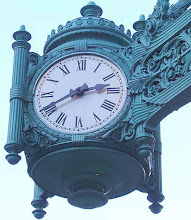I sometimes get asked to recommend books for folks who want to learn more about Marshall Field's. Or just want to oogle photos of Frango mints.

Wait no more. Here's my list of favorite books about Field's. Some of these are scholarly; some are popular. Some are all about Field’s; others just include a few photos or mentions. Taken together, they present a rich history of this beloved grande dame of retail.
They're in alphabetical order, as any good history prof would recommend:
DePaola, Tomi.
With Warmest Regards: A Celebration of Our Customers’ Recipes and Traditions: Dayton’s, Marshall Field’s, Hudson’s. Contemporary Books: 1995.
Ditchett, Samuel Herbert.
Marshall Field and Company: The Life Story of a Great Concern. Dry Good Economist: 1922.
Greene, Joan.
A Chicago Tradition: Marshall Field’s Food and Fashion, Chicago Cultural Center Foundation. Pomegranate, 2005.
Hendrickson, Robert.
Grand Emporiums: The Illustrated History of America’s Great Department Stores. Stein and Day: 1979.
Howard, Vicki.
Brides, Inc.: American Weddings and the Business of Tradition. University of Pennsylvania Press: 2008.
Kimbrough, Emily.
Through Charley’s Door. Harper Collins, 1952.
Leach, William R.
Land of Desire: Merchants, Power, and the Rise of a New American Culture. Vintage: 1994.
Ledermann, Robert P.
Christmas on State Street: 1940’s and Beyond. Arcadia Publishing, 2002.
Lewis, Russell.
Historic Photos of Chicago. Turner Publishing: 2006.
Madsen, Axel.
The Marshall Fields: The Evolution of an American Business Dynasty. Wiley, 2002.
Marshall Field’s,
Marshall Field’s Frango Chocolate Cookbook. Contemporary Books, 1988.
McNulty, Elizabeth.
Chicago Then and Now. Thunder Bay Press, 2000.
Pridmore, Jay.
Marshall Field’s (A Building Book). Pomegranate, 2002.
Twyman, Robert W.
The History of Marshall Field and Company, 1852-1906. Beaufort Books,1976; ACLS Humanities E-Book, 2008.
Siegelman, Stephen.
The Marshall Field’s Cookbook: Classic Recipes and Fresh Takes from the Field’s Culinary Council. Book Kitchen, 2006.
Someone’s in the Kitchen with Dayton’s, Marshall Field’s, Hudson’s. Contemporary Books: 1992.
Vikochil, Larry A.
Chicago at the Turn of the Century in Photographs: 122 Historic Views from the Collections of the Chicago Historical Society. Dover: 1984.
Wendell, Ann.
Frederick & Nelson. Arcadia Publishing, 2008.
Wendt, Lloyd.
Give the Lady What She Wants: The Story of Marshall Field and Co. 1951, 1965, 1997.
Werner, Jane.
Uncle Mistletoe (Little Golden Book). Simon and Schuster: 1953.
Whitacker, Jan.
Service and Style: How the American Department Store Fashioned the Middle Class. St. Martin’s Press: 2006.

If you just want a great read, pick up
Give the Lady What She Wants or
Through Charley's Door. They're both delicious reads.



 My mother (who will hate me because she hates seeing photos of herself but I think she looks great) and my darling niece Annie.
My mother (who will hate me because she hates seeing photos of herself but I think she looks great) and my darling niece Annie.






